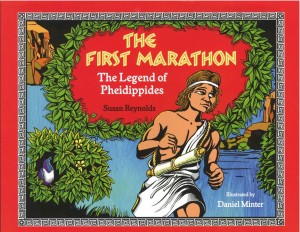Last week’s explosion at the Boston Marathon was heartbreaking for so many reasons. The fact that the vast majority of casualties came from the spectators, including the death of the young boy who had just celebrated his First Communion, is beyond belief.
When I was a tween, my family was in Boston and saw the finish of the Boston Marathon (Bill Rodgers won that year), and it is what started me and my family of origin running all those decades ago. I’ve done several big-city races and one of the things that can be tricky for my family is reuniting again and finding each other after the race. It’s just so awful to think about a marathon, a test of endurance, accomplishment and the human spirit, being always associated with a terrorist attack, and sadness.
I promise to share a picture book, and one related to marathoning, but I have to digress for a moment to quote GK Chesterton. We were reading Chesterton’s The Man Who Was Thursday (my choice) in a Catholic women’s book group to which I belong.
(A further digression: I actually apologized to the ladies during our discussed the book because I found it so difficult to read this time. Why? I don’t know. I first read TMWWT in my 20s, and I just loved it, but I’m a different person now and I found it a really hard go. After I finished the book, I felt so guilty that I found this article for us to help our discussion of the book.)
One quote that stood out for me when seeing the video and photos of Boston was a description of how Syme, the hero of TMWWT, is radicalized (in a good way) against anarchy and disorder in society both by his “anything-goes” upbringing as well as being a bystander to an Anarchist bombing:
“His hatred of modern lawlessness had been crowned also by an accident. It happened that he was walking in a side street at the instant of a dynamite outrage. He had been blind and deaf for a moment, and then seen, the smoke clearing, the broken windows and the bleeding faces. After that he went about as usual–quiet, courteous, rather gentle; but there was a spot on his mind that was not sane. He did not regard anarchists, as most of us do, as a handful of morbid men, combining ignorance with intellectualism. He regarded them as a huge and pitiless peril.”
Lots to ponder there, which is the only saving grace of Chesterton and TMWWT–the quotes to wrestle with and consider.
Okay, digression over.
An interesting and little-known factoid about the modern marathon marathon is the legend of how it came to be.
Briefly, the military messenger Pheidippides runs from the battle of Marathon to Athens to deliver the message the Greeks had defeated the Persians, but when he finished, he dropped dead from the exertion.
You may be wondering, how can this work as a picture book? It just does in the clever The First Marathon: The Legend of Pheidippides by Susan Reynolds, illustrated by Daniel Minter.
 Author Susan Reynolds got the idea to write this book on the flight home from running her first marathon. She tells the story of both what marathons are today, and the story of how the first marathon may have been run by the brave and Pheidippides.
Author Susan Reynolds got the idea to write this book on the flight home from running her first marathon. She tells the story of both what marathons are today, and the story of how the first marathon may have been run by the brave and Pheidippides.
Talk about endurance!
The illustrations are colorful and optimistic, and there is a map to show his route and the surrounding Greek countryside. Children and marathoners alike will marvel at how Pheidippides ran the 26.2 miles from Marathon to Athens after running hundreds of miles delivering messages for the Greek army.
I actually own this book, but I can’t locate it right now to take some photos, but it’s really worthwhile getting from the library, or to own if you’re a runner.
Do you know any good picture books about running or marathons?